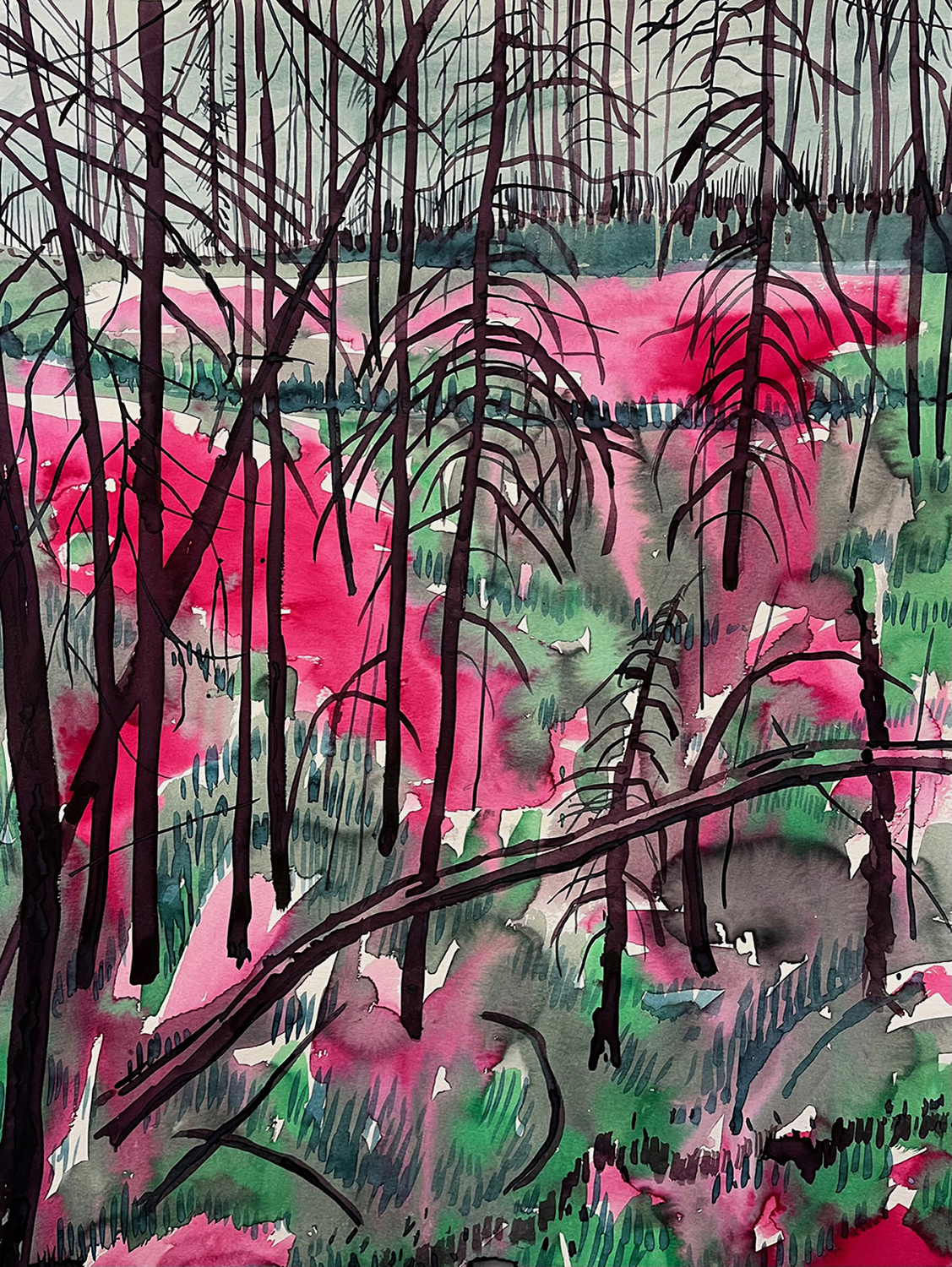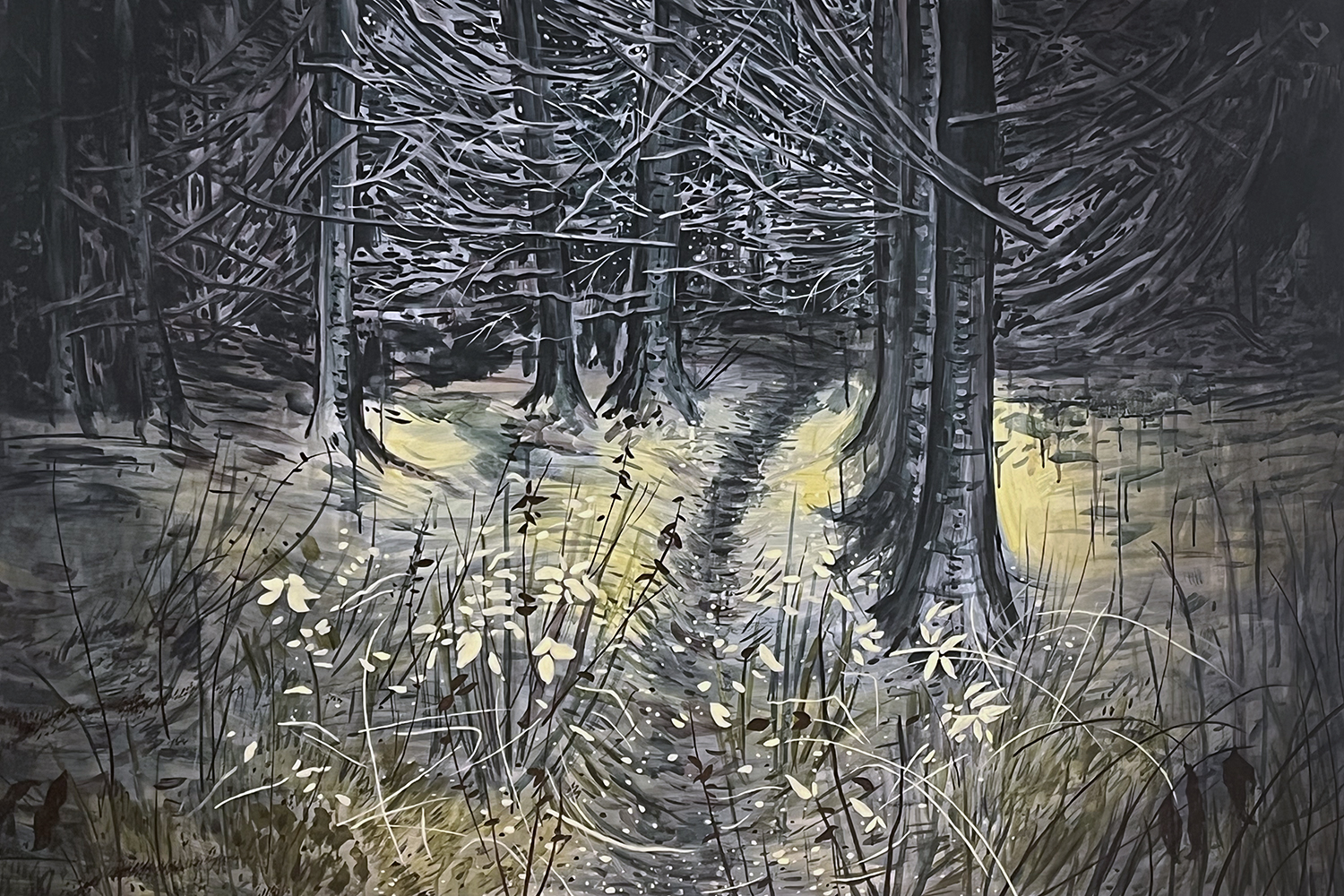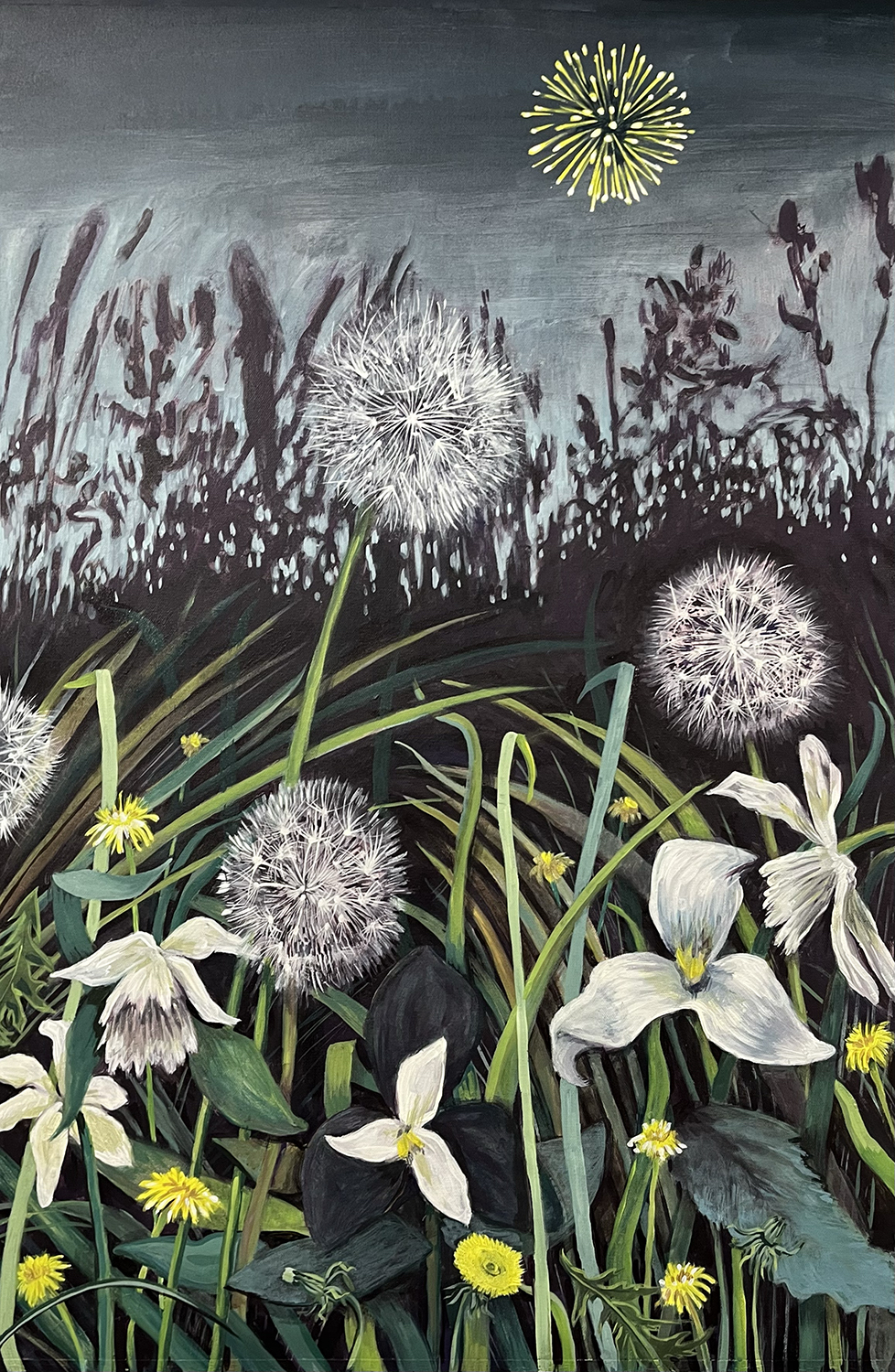Kendra Larson is a Pacific Northwest artist whose work reflects her relationship with and her reverence for her local natural environment. Her multifaceted art practice includes drawing, painting, sculpting, and installation. Nostalgic memories of her youth in the PNW and contrasts between the allure of pristine nature and the effects of human intervention influence her landscape works.
Kendra recently participated in exhibitions at the Buckley Center Gallery at the University of Portland and also at the Augen Gallery in Portland.
What is your personal relationship with nature?
I grew up climbing trees and exploring Mill Creek in Salem, Oregon, a cloudy town sandwiched between two mountain ranges. Painting and drawing that landscape swallowed my time and has become my greatest passion. I see nature as an endless source of mystery, emotion, and painting fodder.
What is your source material for the scenes you paint?
My sources are photos taken on hikes, sketches, and images gleaned from social media. An image might come to mind and I need to seek out sources to help work through possible compositions. I like using a combination of sources and then quickly leaving that initial source behind once the paint hits the canvas. I welcome play into my process and it then becomes a collaboration with the paint.
Do you paint en plein air, in addition to your studio?
I do sketches or studies en plein air, but the large-scale paintings are done in the studio.
Do you have a favorite place in the outdoors?
Oh, that is a tough question! I guess it would be Cascade Head. It is a gem of a hike through the woods, which ends with a view of the Pacific Ocean. Wikipedia says it is a 102,110-acre UNESCO biosphere reserve and United States Forest Service Experimental Forest. I just love the light, smell, and variety of this place.
Your exhibition at the Buckley Center Gallery – Night: New Works by Kendra Larson – focuses on the natural world after dark. Why have you approached depicting nocturnal landscapes when this motif has primarily been portrayed in the daylight?
Light has been a profound subject for many painters throughout history, especially landscaper painters. My work is no exception. One reason I’m interested in nocturnal scenes specifically it that is provides a different type of light. There is a drama to the contrast of light and dark. Another aspect that captures my heart is the mystery – at night details are distorted, animals emerge, and shadows can play tricks on us. It seems appropriate that, at night when we are asleep and at our most vulnerable, our subconscious mind is providing us strange, surreal dreams. My dreams, like my paintings, are often more subtly magical than disturbing.
An example of this is the painting Foothills, which depicts a place in Eastern Oregon with an exaggerated color palette and personified trees. I also find that paintings set in day are somehow too cheerful, too easy to digest and I like the challenge that comes from subverting that.

Foothills, 2022
Perhaps it is because at night I feel most connected, spiritually, to the natural world. Finally, I like the nocturnal environments because of the history of storytelling that they can pay homage to. I love researching traditions and folklore. For instance, Cinderella, Sleeping Beauty, and Hansel and Gretel all conjure night themes. My painting, The Clearing is a good example of this. This piece feels like a stage full of suspense, where the anticipated characters are replaced by trees and shadows. The viewer can imagine their own narrative and complete the piece to their own satisfaction.

The Clearing, 2023
You seem to speak to the inherent intelligence of nature in your work. Can you elaborate on how that is portrayed in your paintings?
That is a great question. I am interested in the inherent intelligence of nature. I’m reading The Hidden Life of Treesright now and it is totally fascinating how brilliant trees are. Their intelligence is apparent in their communicating and working collaboratively. It is different than ours of course, but no less effective.
As far as my work, I think this is portrayed in the compositions I choose and my paint application. The places I choose to paint are often wooded, full of a variety of plants all working together. The horizon is often hard to make out, hidden behind a hill or trees, which requires the viewer to consider a different understanding of order and pattern. Like the Fibonacci sequence found in shells and flowers, there is an order that might not be instantly apparent.
An example of this is the painting Rain and Skunk Cabbage: to transverse this landscape one would need to climb, duck, and accept the rules of the forest. This soggy scene is also very special to the Pacific Northwest and I like that you can almost smell the rain in this piece.

Rain and Skunk Cabbage, 2023
The inherent intelligence of nature also seems to parallel human intuition. My paint application is loose, washy layers contrasting drawn marks. There is a rhythm and musicality to the process that feels tied to nature as well. The painting Lupine and Dragons exhibits this; the brush strokes in this piece seem to make the trees sway and the white outlines give all the plants a sense of vibrating energy. There is a heartbeat to this piece.

Lupine and Dragons, 2022
Occasionally there are humans or insinuations of human presence in your work. Are these depictions snapshots from life or memory? Are you portraying a harmonious commingling or are you weary of human’s intrusion on nature?
Yes, some of the figures are from my life and some are from my memories. Let me first state that when there is no figure illustrated in my landscapes there is still the presence of the viewer, and all landscapes are mitigated through a human lens. Both culturally and spiritually we are the landscape.
When I do add a figure, they are always small. This is for scale – I want the landscapes to feel large. My general philosophy is that I am weary of human’s intrusion on nature, but the figures in my paintings are not necessarily illustrating that; they are more complicated. I either do large groups of people or a single person. The groups highlight celebrations or rituals or mischief connected to place.
When I paint a single person, they are a stand-in for the viewer and highlight our emotional relationships with nature (loneliness, connection, disconnection, fear, security, hope). For instance, in the painting Childhood on the Olympics, the boy is my son playing barefoot in the woods on a dusty summer day under a canopy of conifers. My hope is that the viewer can relate and be reminded of the pure childlike joy of summer evenings outdoors.

Childhood on the Olympics, 2022
Your work will be featured in AMcE’s upcoming show, Stasis, including larger-scale pieces. Without revealing too much, can you let us know about the kinds of pieces that you are working on? Any new themes, approaches, or surprises?
I’m really excited about Stasis. All the work is new and hasn’t been shown in Seattle. I feel very honored to show alongside Richard Bruland, Casey Curran, Roni Feldman, Ryana Lawson, and Vander McClain. I’ve been working on ceramics, watercolor drawings, and large-scale paintings of gardens at night. I like the idea of flowers blooming when humans aren’t there to see them. This line of inquiry kind of started with the paintings High Desert Phases (that was shown at the Buckley Center and Night Garden which will be part of Stasis.) These paintings also play with unrealistic light and a kind of otherworldly aura.

Night Garden, 2022


Recent Comments